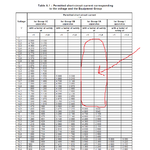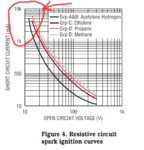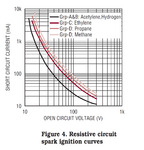hm_fa_da
Full Member level 5

Hi,
In IEC60079-11 for IS circuit design, there is a table showing max permitted short circuit current for different voltages but the problem is the table starts from 14.8V(for IIA gas group) i.e.
I know there is another figure showing the Voltage/Current ratio for different gas groups ignition, but that figure also shows only +10V ...
1-Does it mean we don't have any short circuit current limitation for lower voltages than 14.8V for IIA ??
2-Or i have to consider the first value for lower voltages ? i.e for IIA safety factor 1.5, max 3300 mA for any voltage lower than 14.8V too ?
I have attached the table, as you see for IIA, the voltage range with value in the table starts from 14.8V.

In my case, the circuit has maximum voltage of 3.9V only.
Thanks
In IEC60079-11 for IS circuit design, there is a table showing max permitted short circuit current for different voltages but the problem is the table starts from 14.8V(for IIA gas group) i.e.
I know there is another figure showing the Voltage/Current ratio for different gas groups ignition, but that figure also shows only +10V ...
1-Does it mean we don't have any short circuit current limitation for lower voltages than 14.8V for IIA ??
2-Or i have to consider the first value for lower voltages ? i.e for IIA safety factor 1.5, max 3300 mA for any voltage lower than 14.8V too ?
I have attached the table, as you see for IIA, the voltage range with value in the table starts from 14.8V.

In my case, the circuit has maximum voltage of 3.9V only.
Thanks





